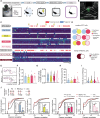This is a preprint.
Deconstruction of a Memory Engram Reveals Distinct Ensembles Recruited at Learning
- PMID: 39975896
- PMCID: PMC11838775
- DOI: 10.21203/rs.3.rs-5633532/v1
Deconstruction of a Memory Engram Reveals Distinct Ensembles Recruited at Learning
Abstract
How are associative memories formed? Which cells represent a memory, and when are they engaged? By visualizing and tagging cells based on their calcium influx with unparalleled temporal precision, we identified non-overlapping dorsal CA1 neuronal ensembles that are differentially active during associative fear memory acquisition. We dissected the acquisition experience into periods during which salient stimuli were presented or certain mouse behaviors occurred and found that cells associated with specific acquisition periods are sufficient alone to drive memory expression and contribute to fear engram formation. This study delineated the different identities of the cell ensembles active during learning, and revealed, for the first time, which ones form the core engram and are essential for memory formation and recall.
Conflict of interest statement
Competing interests: Authors declare that they have no competing interests.
Figures




References
-
- Maren S. NEUROBIOLOGY OF PAVLOVIAN FEAR CONDITIONING. Annu. Rev. Neurosci. 24, 897–931 (2001). - PubMed
-
- Ramirez S. et al. Creating a False Memory in the Hippocampus. Science 341, 387–391 (2013). - PubMed
-
- Tonegawa S., Liu X., Ramirez S. & Redondo R. Memory Engram Cells Have Come of Age. Neuron 87, 918–931 (2015). - PubMed
Publication types
Grants and funding
LinkOut - more resources
Full Text Sources
Miscellaneous

